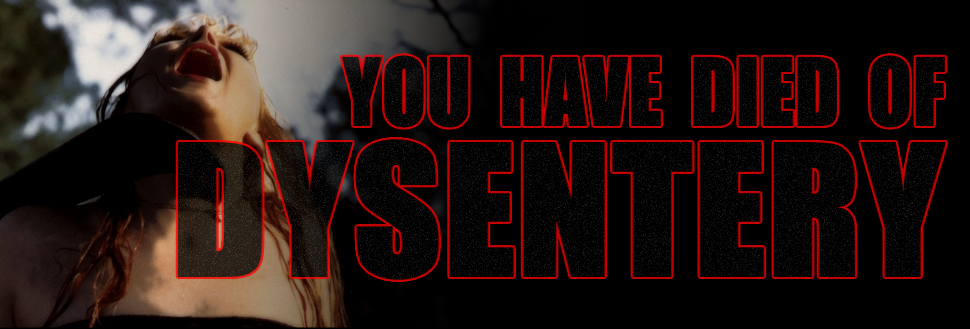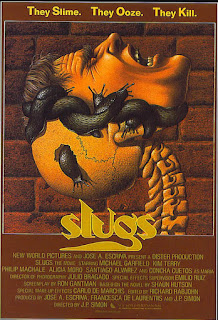The 1972 directorial
debut from Charles B. Pierce, THE LEGEND OF BOGGY CREEK, feels like a
film meant for a small audience. The subject of the film is the Fouke
Monster, a Bigfoot-like cryptid that allegedly dwells in the swamps
and countrysides of Fouke, Arkansas, a small town with less than
1,000 inhabitants. It’s difficult to imagine that anyone outside
The Natural State had ever heard of the Fouke Monster before 1972. It
was a small town legend, confined by city limits. Pierce brought it
to the national stage.
THE LEGEND OF BOGGY
CREEK was a major financial success, raking in an estimated 25
million on a meager $100,000 budget. It created the template for the
docu-horror and the television series In Search Of…. It’s
impossible to imagine films like THE LAST BROADCAST and THE BLAIR
WITCH PROJECT existing without it. It might not
get name dropped a lot in conversations about influential genre
films, but make no mistake, the influence of THE LEGEND OF BOGGY
CREEK lives on today, strong as ever.
But influence aside,
THE LEGEND OF BOGGY CREEK is not some little seen masterpiece. I
wrestle with even calling it a good film. It’s a curio piece, for
sure, a film that should be seen by every genre fan simply for what
it represents, for the impact it had, and for the sake of historical
perspective. However, the film itself is fairly tame and has been rendered
all but obsolete by time. For a first effort in the docu-horror sub-genre, it works quite well. As
a straight forward horror film, time has robbed it of its charms.
The film begins with
some lovely nature photography. Woods, fields, swamps, rivers, etc.
We see a young boy running through a field. A narrator chimes in to
explain what we’re seeing. This is him as a boy, scared shitless,
running to get some help. His mother spotted the creature again, a
hulking, hairy beast that lurks around their property. The boy’s
story is disregarded by some townsfolk. THE LEGEND OF BOGGY CREEK, we
surmise, is a film made by that young boy, now returned to the area
as an adult to tell others about the legend that has haunted him since childhood.
This is of course a
total ruse. The narrator is a work of fiction. All the on-screen
encounters with the beast are fake, nothing more than reenactments.
THE LEGEND OF BOGGY CREEK is just a ghost story we are being told,
but instead of a bonfire, we’re gathered around a cinema screen. I
imagine these were the tales adults told to children in Fouke,
Arkansas. “Better get to bed or the Fouke Monster will get ya”.
For people whose homes looked out upon the woods and fields at night,
THE LEGEND OF BOGGY CREEK must have scared them to death.
But for someone like
myself, viewing the film in 2017 from the confines of a concrete
jungle, THE LEGEND OF BOGGY CREEK is just a repetitive experience
with a few good moments to break up the overall monotony. And it is a
repetitive experience. The majority of the film is nothing more than
dramatizations. Here we see a man chasing off something in the dark
with his rifle. Next we see the monster terrorizing some girls in a
small home in the woods. Now we see a young boy coming face to face
with the beast while tracking a deer. The film is a long list of
monster encounters, some of them good, some of them bad. The final
third of the film is its strongest. It settles down for a lengthy
tale of an encounter with the beast, one that quickly becomes a
mini-home invasion thriller, albeit one in which the trespasser has
giant fake claws.
Because this is a
docu-horror and not a full blown mockumentary, there is no grand
narrative to all of this, no connective tissue holding the film
together. It is simply a collection of mini-horror flicks, a series
of encounters that builds ever so slightly in intensity as it goes
on. THE LEGEND OF BOGGY CREEK made a killing at the drive-ins and
it’s easy to see why. The episodic nature of the film works well in
that environment. People coming in late wouldn’t miss anything. You
could dive in and out of the film while diving in and out in the
backseat. Trips to the concession stand wouldn’t ruin the
experience. Sitting down on the couch and watching the film in one
uninterrupted go seems like the wrong way to watch it. Undivided
attention is a negative here.
Turns out, telling
the tale of Boggy Creek as an honest to goodness narrative film would
be a negative too. Tom Moore’s RETURN TO BOGGY CREEK, a 1977 follow
up, ditches the docu-horror formula for a family friendly nature
adventure narrative, killing any chills (and box office appeal) along
the way. The proper sequel to the film would come when Pierce
returned in 1985 with BOGGY CREEK II: AND THE LEGEND CONTINUES.
Like RETURN TO BOGGY
CREEK, Pierce’s sequel tries to play it straight, with a
traditional narrative in lieu of the docu-horror style of the
original film. Taking a page out of his own THE EVICTORS formula,
Pierce does include a few reenactments of encounters with the beast,
the best (and most hilarious) involving a man in an outhouse. As the
film plods along, it pays homage to several horror films, most
notably CUJO, JAWS and ALIEN. The beast looks better here than it did
in the original. In the 1972 film, it was just a large man covered in
shag carpeting wearing monster gloves. Here, the beast actually looks
like a proper Sasquatch.
Unfortunately,
that’s the only positive about the film. BOGGY CREEK II: AND THE
LEGEND CONTINUES is simply awful, a tiring, dull and uninteresting
mess of a movie whose best scenes are those it shamelessly rips from
other films. There’s a reason it found its way onto Mystery Science
Theater 3000. It’s laughable and inept, certainly a career low for
Pierce.
It’s yet another
case of “you can’t beat the original”. While THE LEGEND OF
BOGGY CREEK is pretty damn far from perfect, I still think it’s a
film worth watching. Personally, I don’t believe in monsters, gods
or ghosts. I don’t believe in the Sasquatch or the lake monsters or
spectral entities. But I certainly love the docu-horror. I grew up
with re-runs of In Search Of…. I could spend hours watching wholly
ridiculous, obviously fake shit like MonsterQuest or Arthur C.
Clarke’s Mysterious World. I find the idea of monsters fascinating.
Part of me wishes they were real, that there were beasties and
creatures of legend lurking in the forests, waiting to terrify hikers
and trespassers.
Unfortunately, the
only monsters that exist are human. But when I sit and watch a film
like THE LEGEND OF BOGGY CREEK, I get to be a kid again, curious of
what may lurk outside the comfy confines of city living. It might not
be the best example, but it deserves respect for being a true
trendsetter. Without it, the landscape of horror would look quite
different.











